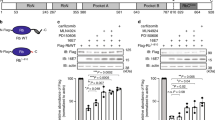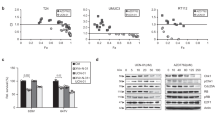Abstract
THE transforming proteins of several DNA tumour viruses, including adenovirus Ela and simian virus 40 large T antigen, complex with the retinoblastoma (Rb) tumour-suppressor gene product1,2. This requires regions in these viral proteins necessary for transformation and is thought to inactivate the growth-suppressing properties trf the Rb protein by disrupting its interaction with cellular targets3. Indeed, regions of Rb required to form a complex with Ela and large T antigen are often mutated in transformed cells4. The level at which the Rb protein regulates proliferation is unknown, although one possibility is transcription. We have previously characterized a sequence-specific transcription factor, DRTF1, the activity of which is downregulated as embryonal carcinoma stem cells differentiate. DRTF1 is found in several discrete protein complexes (a, b and c) which are of different sizes but have the same DNA specificity5,6. We now show that one of these also contains the Rb protein and, further, that the adenovirus E1a protein causes the dissociation of the Rb protein from this complex. This requires conserved regions 1 and 2 of E1a that are known to be required for efficient transformation7. These results demonstrate that the Rb protein forms a complex with a DNA-bound transcription factor, and suggests that the Rb protein might act by regulating transcription.
This is a preview of subscription content, access via your institution
Access options
Subscribe to this journal
Receive 51 print issues and online access
$199.00 per year
only $3.90 per issue
Buy this article
- Purchase on Springer Link
- Instant access to full article PDF
Prices may be subject to local taxes which are calculated during checkout
Similar content being viewed by others
References
Whyte, P. et al. Nature 334, 124–129 (1988).
DeCaprio, J. A. et al. Cell 54, 275–283 (1988).
Kaelin, W. G., Pallas, D. C., DeCaprio. J. A., Kaye, F. J. & Livingston, D. M. Cell 64, 521–532 (1991).
Hu, Q., Dyson, N. & Harlow, E. EMBO J. 9, 1147–1155 (1990).
La Thangue, N. B. & Rigby, P. W. J. Cell 49, 507–513 (1987).
Shivji, M. K. & La Thangue, N. B. Molec. cell. Biol. 11, 1686–1695 (1991).
Lillie, J. W., Lowenstein, P. M., Green, M. R. & Green, M. Cell 50, 1091–1100 (1987).
La Thangue, N. B., Thimmappaya, B. & Rigby, P. W. J. Nucleic Acids Res. 18, 2929–2938 (1990).
Imperiale, M. J., Kao, H.-T., Feldman, L. T., Nevins, J. R. & Strickland, S. Molec. cell. Biol. 4, 867–874 (1984).
Moran, E., Zerler, B., Harrison, T. M. & Mathews, M. B. Molec. cell. Biol. 6, 3470–3480 (1986).
Whyte, P., Williamson, N. M. & Harlow, E. Cell 56, 67–75 (1989).
La Thangue, N. B., Shriver, K., Dawson, C. & Chan, W. L. EMBO J. 3, 267–277 (1984).
Tassios, P. T. T. & La Thangue, N. B. The New Biologist 2, 1123–1134 (1990).
Author information
Authors and Affiliations
Rights and permissions
About this article
Cite this article
Bandara, L., La Thangue, N. Adenovirus E1a prevents the retinoblastoma gene product from complexing with a cellular transcription factor. Nature 351, 494–497 (1991). https://doi.org/10.1038/351494a0
Received:
Accepted:
Issue Date:
DOI: https://doi.org/10.1038/351494a0
This article is cited by
-
CRISPR/Cas9 and next generation sequencing in the personalized treatment of Cancer
Molecular Cancer (2022)
-
Differential regulation of mammalian and avian ATOH1 by E2F1 and its implication for hair cell regeneration in the inner ear
Scientific Reports (2021)
-
SKA3 promotes cell proliferation and migration in cervical cancer by activating the PI3K/Akt signaling pathway
Cancer Cell International (2018)
-
Pleiotropic effect of somatic mutations in the E2F subunit DP-1 gene in human cancer
Oncogene (2014)
-
Arginine methylation controls growth regulation by E2F-1
The EMBO Journal (2012)
Comments
By submitting a comment you agree to abide by our Terms and Community Guidelines. If you find something abusive or that does not comply with our terms or guidelines please flag it as inappropriate.



